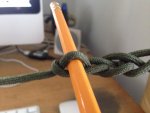Wavephf
Observer
Took the dogs out for a ride hoping to find some hunting spots. I knew the trail I was going on would have snow on it so I made sure to bring some tire chains. Before I hit the deep snow I put the tire chains on the front of my truck because the last time I was in the snow I couldn't get the chains on after I got stuck. I made it almost to the top of trail but couldn't make the last 200 feet so I decided to turn around and head back down. The problem is I had to back down the trail and find a flat spot to turn around. The flat spot I found wasn't as flat as I thought and when I started to drive back forward my truck slip down next to a tree.

So I check what gear I have and decide what my options are.
1. Use my spot messenger to call for help
2. Go hunting for food (the only animals I have seen are my dogs)
3. Use my hi-lift and week old Off Road Kit ORK to attempt self recovery

My dogs found a deer antler and don't seem to care much about leaving this place.

ORK setup one. Short strap attached to bumper support on one end and the hi-lift on the other. ORK attached to 10' chain attached to 20' chain attached to 20' strap attached to large tree on uphill side of trail. Second strap added to help center the chain on the trail.


The first setup was very slow because the jack handle hits the bumper on the truck.
ORK setup two. Used 2 straps and 20' chain to bridge the gap between two trees, one on each side of the road. Hooked the hi-lift to the chain in the center of the road and the ORK to the 10' chain-strap-truck.

The second setup work alot faster. Pulled myself about three feet away from tree. I left the ORK and straps hooked up to the back of the truck and started driving down the trail. This help slide the rear end further away from the tree.


Back down the trail and on clear ground to remove the tire chains.


I still had some time to kill before heading home so I setup my hammock to take a break and enjoy the view.



So I check what gear I have and decide what my options are.
1. Use my spot messenger to call for help
2. Go hunting for food (the only animals I have seen are my dogs)
3. Use my hi-lift and week old Off Road Kit ORK to attempt self recovery

My dogs found a deer antler and don't seem to care much about leaving this place.

ORK setup one. Short strap attached to bumper support on one end and the hi-lift on the other. ORK attached to 10' chain attached to 20' chain attached to 20' strap attached to large tree on uphill side of trail. Second strap added to help center the chain on the trail.


The first setup was very slow because the jack handle hits the bumper on the truck.
ORK setup two. Used 2 straps and 20' chain to bridge the gap between two trees, one on each side of the road. Hooked the hi-lift to the chain in the center of the road and the ORK to the 10' chain-strap-truck.

The second setup work alot faster. Pulled myself about three feet away from tree. I left the ORK and straps hooked up to the back of the truck and started driving down the trail. This help slide the rear end further away from the tree.


Back down the trail and on clear ground to remove the tire chains.


I still had some time to kill before heading home so I setup my hammock to take a break and enjoy the view.



